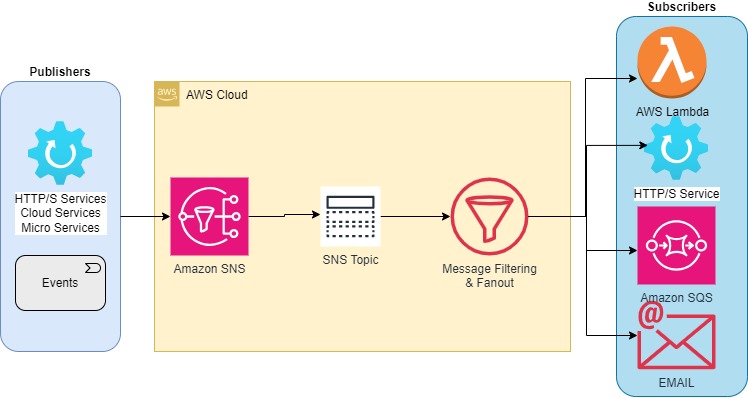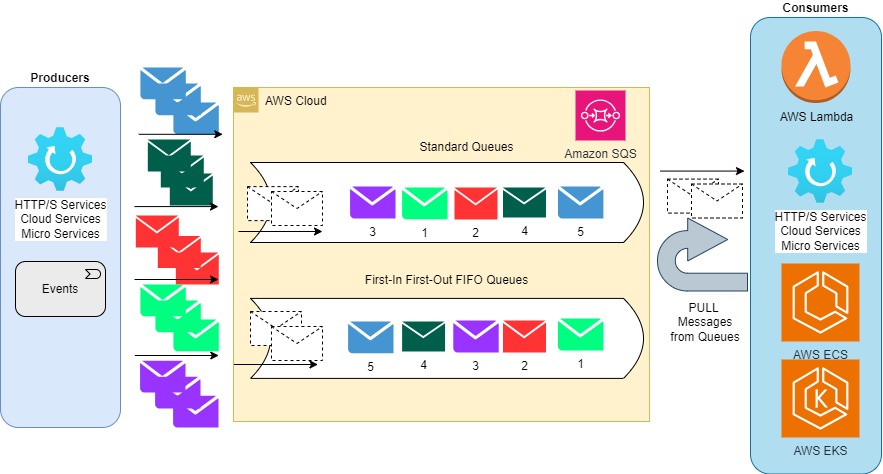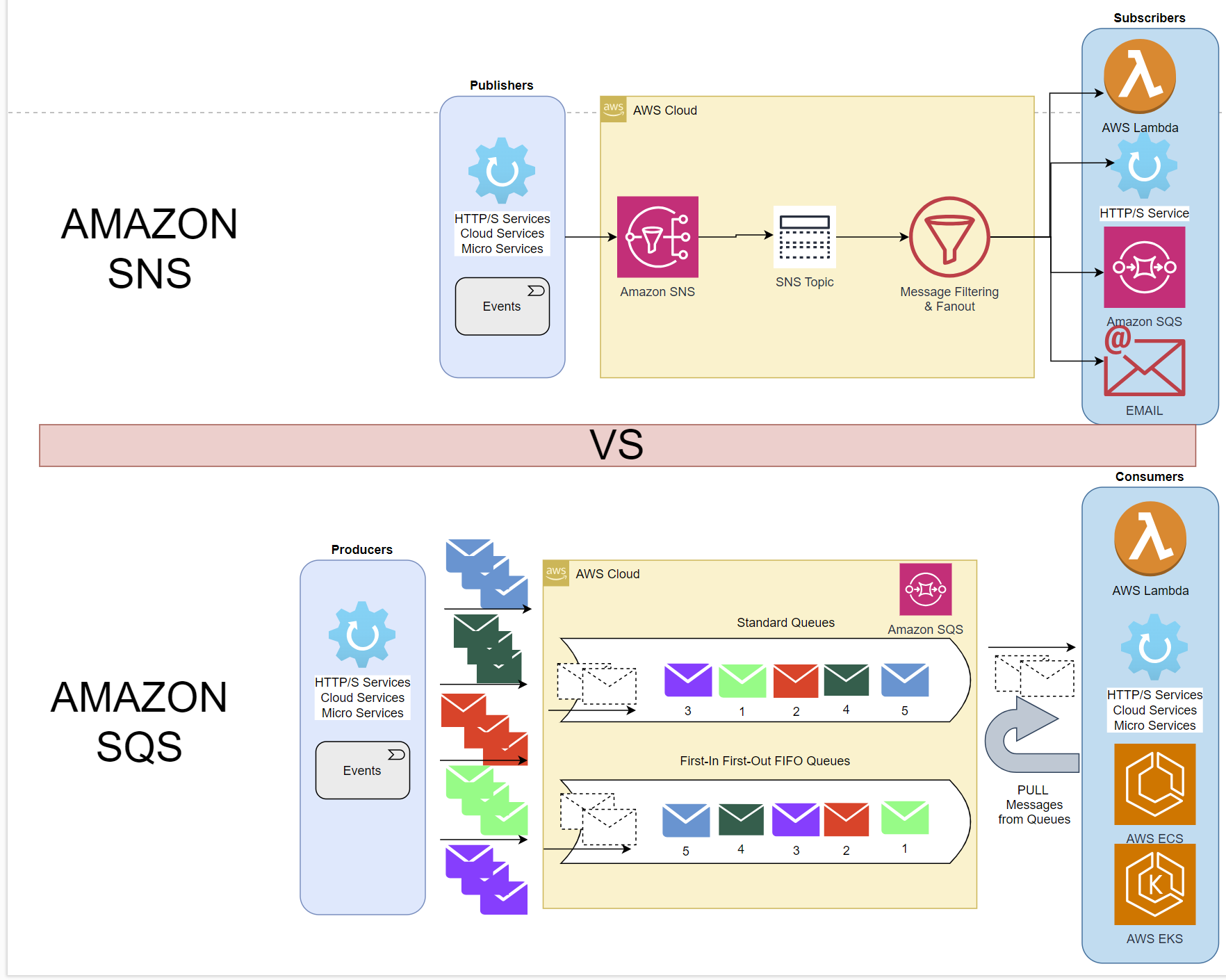What is the difference between Amazon SNS and Amazon SQS?
When it comes to cloud-based messaging services, Amazon offers two powerful tools: Amazon SNS (Simple Notification Service) and Amazon SQS (Simple Queue Service). Both are part of AWS (Amazon Web Services) and are used to manage communication between different parts of an application. However, they serve different purposes and work in distinct ways. In this article, we’ll explore the key differences between Amazon SNS and Amazon SQS, and how you can decide which one to use in your cloud computing setup.
What is Amazon SNS?
Amazon SNS (Simple Notification Service) is a fully managed pub/sub (publish-subscribe) messaging service. It allows developers to send messages or notifications to multiple subscribers at once. The main idea behind SNS is broadcasting messages to many receivers (subscribers) in near real-time.

SNS works like this: A publisher (the source of the message) sends a message to a topic. This topic acts like a broadcasting channel. Subscribers, such as applications, services, or users, can subscribe to this topic. Once a message is sent to the topic, SNS delivers the message to all its subscribers via different protocols such as HTTP/S, email, SMS, or Lambda functions.
Key Features of Amazon SNS
- Push Notifications: SNS pushes the message to all subscribers without requiring them to request it. This is a key feature of pub/sub systems.
- Multi-protocol Support: SNS supports various protocols for message delivery, such as SMS, HTTP/S, and Lambda functions. This gives developers flexibility in how they want their messages delivered.
- High Throughput: SNS is built for high performance and can handle millions of messages per second.
- Seamless Integration with AWS Services: SNS integrates well with other AWS services like Lambda, SQS, and CloudWatch, allowing for powerful workflows.
For more detailed information, you can visit the Amazon SNS official page.
What is Amazon SQS?
Amazon SQS (Simple Queue Service) is a fully managed message queuing service. It allows decoupling of components in a distributed application by enabling asynchronous message passing between them. Messages sent to an SQS queue are stored until they are retrieved and processed by a consumer.

Unlike SNS, SQS is a pull-based system. This means the consumer needs to poll the queue to receive messages. The main purpose of SQS is to ensure that messages are delivered reliably and are processed only once, even if different parts of the system are running at different speeds.
Key Features of Amazon SQS
- Message Queueing: SQS is designed to decouple systems and handle messages asynchronously. This is especially useful when different components of an application run at different speeds.
- Guaranteed Delivery: Messages in SQS are stored until they are successfully processed by a consumer. This guarantees that every message will be delivered at least once.
- Scalability: SQS is designed to handle large volumes of messages and can scale automatically based on the load.
- Different Queue Types: SQS offers two types of queues:
- Standard Queues: Best for applications that require high throughput but can tolerate messages being delivered more than once or out of order.
- FIFO Queues: Ensures that messages are delivered exactly once and in the order they were sent. FIFO queues are perfect for use cases where order and uniqueness are critical.
For more details, you can check out the Amazon SQS official page.
The Key Differences Between Amazon SNS and Amazon SQS
Now that we understand what SNS and SQS are, let’s highlight the key differences between them.
- Message Model
- SNS: SNS follows a pub/sub model where messages are pushed to multiple subscribers at the same time.
- SQS: SQS follows a queuing model where messages are stored in a queue until a consumer retrieves them.
- Push vs. Pull
- SNS: SNS is a push-based system. Messages are automatically delivered to subscribers without any request from them.
- SQS: SQS is a pull-based system. Consumers must actively poll the queue to retrieve messages.
- Use Case
- SNS: Best for use cases where you need to broadcast a message to many subscribers in real-time, like sending alerts or notifications.
- SQS: Ideal for decoupling services in an application and ensuring reliable message delivery. It’s best when components of your application run at different speeds and require guaranteed delivery.
- Message Retention
- SNS: Messages in SNS are not stored after delivery. Once the message is sent to subscribers, it is no longer available.
- SQS: Messages in SQS are stored until a consumer retrieves and processes them, up to 14 days.
- Message Duplication and Order
- SNS: Since SNS is a pub/sub service, it does not guarantee the order or uniqueness of messages. Messages can be duplicated.
- SQS: SQS offers two queue types. Standard queues may deliver messages more than once or out of order, while FIFO queues ensure messages are delivered exactly once and in the correct order.
When to Use Amazon SNS?
Here are some use cases where SNS shines:
- Real-time Notifications: Sending alerts to multiple devices (email, SMS, mobile push notifications) in real-time.
- Broadcasting Events: Distributing updates from a central system to various downstream systems or services, like updating multiple microservices when a new customer signs up.
- Integrating with AWS Lambda: Triggering AWS Lambda functions when certain events happen.
When to Use Amazon SQS?
SQS is a great fit for the following scenarios:
- Decoupling Microservices: If you have different parts of your application that need to work independently, SQS ensures that one part can send messages without needing to wait for another part to process them.
- Reliable Message Processing: If you need to ensure that every message is delivered exactly once and processed in the right order, especially in transactional systems.
- Handling High Throughput: SQS can handle a large number of messages and automatically scales to match the volume.
Can SNS and SQS Work Together?
Yes! In fact, they often do. You can combine SNS and SQS to build a flexible, scalable, and reliable messaging system. For example, you can use SNS to send a message to multiple queues and then have SQS queues process the messages at their own pace. This is useful when you want to broadcast messages but still need to ensure reliable delivery to individual systems.
Conclusion
Both Amazon SNS and Amazon SQS are powerful messaging services in AWS, but they serve different purposes. SNS is perfect for real-time notifications and broadcasting messages, while SQS is best for ensuring reliable, asynchronous message processing. The choice between them depends on your application’s specific needs.
For more information on these services, visit the official pages for Amazon SNS and Amazon SQS. You can also explore AWS documentation for deeper insights and tutorials on how to set them up in your cloud architecture.





